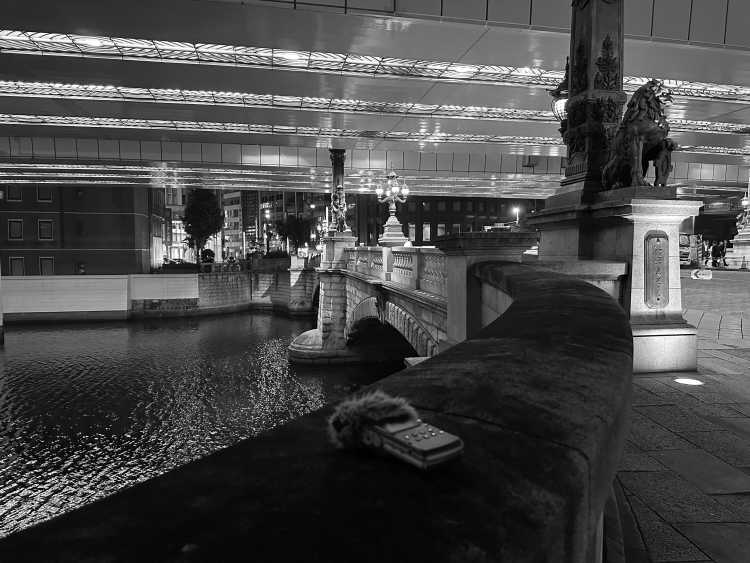MSCTY x Nihonbashi
MSCTY x Tokyo [in Nihonbashi]
An exploration of history and culture through a living, breathing soundwalk.
OVERVIEW
Weaving the Seeds of Tokyo!
"Create Linkage" is the slogan of Tokyo Biennale 2023, and for our project, we celebrate connections between sound, space, history, and culture, in a unique part of Tokyo – which is often called the centre of the great city.
Along with 9 collaborators, we embed 10 new soundscape artworks in the Nihonbashi area that connect listeners to particular elements of the area's heritage.
We dig into 7 longtime-established shops specialising in traditional Japanese foods and crafts, along with 2 of the country's [surely the world's!] most historically significant, ambitious, and iconic flagship department stores: Mitsukoshi and Takashimaya!
All together our project forms a soundwalking route that enables new appreciations for listeners and WEAVES THE NIHONBASHI AREA WITH SOUND.
We are very happy to work with esteemed collaborators for this project: Ai Kakihira, Coppé, Logic System, Yumiko Morioka, Moshimoss, Ken Nishikawa, Takashi Nishimoto, Noah, and the sleeping beauty.
ARTISTS + TRACKS
“Intended to accompany those walking around the historical streets of the area, ‘Nihonbashi Sound Weave’ has its grounding basis in sounds collected from the bridge at the heart of the area–the Nihonbashi. We used samples of the bridge and water to create an ambient, dream-like, ‘music box’ melody from notations and harmony based on key elements of local history.
On top of this, we weave in distant ‘memories’ of the locations surrounding this area: the old friends that are the selected shops and department stores explored as part of this whole project.
It is hoped that listeners can take a moment out of the present as they listen and explore: being transported on a sonic journey beyond history and beyond time, to connect to generations of life in the area.” [MSCTY_Studio]
“I visited the store during my research for this track, and I was very impressed by the words of the Omi merchants, who are the roots of Tagen. What our ancestors have protected and what they wanted to leave behind.
I could hear the sound of wind chimes outside the window. I wrote this song guided by that sound.
The accidental noises and changes in sound were created by the use of analogue equipment and tape recorders which are also essential to this work.” [Ai Kakihara]
“The track was created by a good friend of mine, Uwe Zahn [aka Arovane], and myself using the inspiration from the Edoya ambience.
There was a phase back in 2015, Uwe and I met up for a few sessions and recorded some ideas.
I was going through my hard-drive for an idea, then accidentally discovered an unfinished track.
Prior to that point, I had a chance to visit Edoya as a customer. The shop seems not only very historical but also friendly, and yet efficiently organised for customers. I was looking for a continuous sound, i.e. the sound of wind or moving air. As soon as I found the forgotten track, and listened to the shop’s ambience and the sound of brushes, the track came together almost by itself.“ [Takeshi Nishimoto]
“In this piece of music, Logic System focuses on the long-established process of making washi paper, with a beautifully textural piece of music that flows with electronic and organic elements, providing the perfect accompaniment to a real or imagined visit to Ozu Washi.” [MSCTY_Studio]
“Although the store is located in a big city, it was interesting to feel the simple and primitive relationship between nature [iron, water, and stone] and humans in relief.
I wanted to make it unpredictable and not give too much order to the rhythm, so that it would always intertwine with the local sounds and become a different environmental sound.
So I composed the song as if it were in a jam session with the rhythm of sharpening knives, the sound of water, the sound of a motor, the sound of a tub, and the sound of hammering. The water area where the knives were sharpened sounded like a tranquil garden pond, so I was conscious of that as well and made the work tranquil.
I gave it some gaps and the rhythm was a bit random, like a natural rhythm.” [Moshimoss]
“The inspiration of the track came chiefly from the sound of katsuobushi or dried and fermented bonito being shaved and the monologue of the lady explaining the complex process of creating pure umami and hence the title “All you need is umami". I wanted the piece to be non-disruptive, total musique d’ameublement, but with some harmonic, rhythmic and melodic "umami". Unbeknownst to whoever assigned me for creating the soundtrack for Ninben, not only is Ninben's "Tsuyu no moto" my family's go-to soup base, my mother's side of the family is [very, very] distantly related to the Ninben founder's family - an unbelievable coincidence! My great grandfather, Matsu, was born and raised in Higashi Ginza, behind the Kabuki theatre in the late 19th century. He was a kanzashi shokunin – or a hair-ornament craftsman.
One day, he saw a beautiful young girl in Nihonbashi - it was love at first sight. Sadly, it wasn’t quite the same for her - for she was, alas, blind. However, so was his love for her. Matsu saw her family and told them that he wanted to marry her. Her family was hesitant because, whereas they were a wealthy merchant family, he was just a poor young apprentice, a labourer. It's an insurmountable class-gap back in those days. Undeterred, Matsu was very insistent and, partially due to her disability, her family finally relented. This beautiful young blind lady was said to be related to the Ninben family. But the surprising element doesn't end there; according to my family legend, after marrying my great grandfather, my great grandmother regained her eyesight! This fairytale-isque love story took place over a century ago and no one that can verify the story is alive. It's a nice tale, nonetheless, and I could not resist sharing it with you. And this little family history was always on my mind when I composed and produced the soundtrack.” [Ken Nishikawa]
“There is a Japanese visual art in which the artist is forced to be spontaneous. He must paint on a thin stretched parchment with a special brush and black water paint in such a way that an unnatural or interrupted stroke will destroy the line or break through the parchment. Erasures or changes are impossible.
The resulting pictures lack the complex composition and textures of ordinary painting, but it is said that those who see will find something captured that escapes explanation."
"The above is a quote from Bill Evans’ liner notes from the original 1959 LP Release of Miles Davis ‘Kind of Blue.’ When we received a message from MSCTY asking us to make music for Yubendo, we immediately said “yes!” It was because of the inspiration we received just by thinking of Yubendo.
Japanese writing paper. Brushes. Black ink. Those tools sold at Yubendo and sound clips recorded at Yubendo by MSCTY reminded us of many things. The above quote by Bill Evans, which we believe was based on what D. T. Suzuki wrote about Sumi-e, the monochrome ink-and-wash painting, in his ‘Zen and Japanese Culture.’ The serenity of the D.T. Suzuki Museum in Kanazawa, or temple gardens in Kyoto.
So, we wanted to make something that lacks the complex composition of ordinary songs. We recorded only a few takes of the piano and the sax, then mixed them with the sound clips sent from Nick at MSCTY. We resisted the temptation to erase or change our mistakes – because accidental drops of the black ink-and-wash are vital for Sumi-e or Japanese calligraphy. We hope listeners of our music will feel the stillness by accepting those accidental drops.” [The Sleeping Beauty]
“A Dream of Mitsukoshi takes its inspiration from the a fusion of two contrasting elements: the sound recordings and on-location research that we reimagined as a soundscape to conjure the experience of exploring Nihonbashi Mitsukoshi, and also the input of Noah’s reflections on the department store as a place of warmth and beauty that transcends time and place.
Our process for creating the track was to create a soundscape purely based on field recordings of the department store, and provide it to Noah, who in turn responded. This happened over several rounds.
Our musical journey uses reference to the day-to-day careful process of packaging purchases, as well as the store logo itself, and seeks to share with listeners an impression of top-notch service–with shop assistants so much at peace with their work that they almost appear to softly dance and glide through their movements–and the old meets new design of the interior spaces. These conjure a nostalgic blend of period art deco with a modern day cinematic experience through the work of contemporary architect Kengo Kuma to create the feeling of a magical winter forest." [MSCTY_Studio]
“I remember my grandma and grampa taking me to the store to buy me candy, and although these memories are from a long time ago, I remember it all so vividly! The sweetest taste in my mouth and the happiest coppéski! When I worked on my track, right away I was day-dreaming, floating in these super-nostalgic sweetest memories!
I am very honoured and happy to be contributing my music to such a long standing and respected sweet store which has kept me smiling for decades! Also i can totally see my grandma + grampa smiling from heaven :)” [Coppé]
“The piece begins in the morning and ends at sunset in the ‘urban oasis’ that is Nihonbashi Takashimaya’s roof garden. In between, we created a piece of music to capture and conjure up the soul of a national treasure and historical institution in the heart of Nihonbashi.
We used recordings and research collected onsite to build a sound collage and accompanying graphic score: mapping out the experience of travelling through the grandeur of the glorious premises. We take in the early Showa era elevator from 1933, with an attentive attendant executing the highest level of service, and explore the gentle grace of the large ceramics and glassware sections, while following a structure given by the curvatures and repeated shapes of the ceiling.
Yumiko Morioka performed the score on the piano to create a musical journey through the department store, which we treated with subtle processing to create a full bodied sonic world evoking strings being performed in the vast halls of Takashimaya Nihonbashi. At times, our recording collage re-enters the scene, creating an effect that Yumiko likes to call “Takashimaya Space Station!”” [MSCTY_Studio]
Weaving the Nihonbashi Area with Sound at Tokyo Biennale 2023
WATCH THE VIDEO
NIHONBASHI SOUND WEAVE! [15 images]
← Click/Drag/Swipe →














